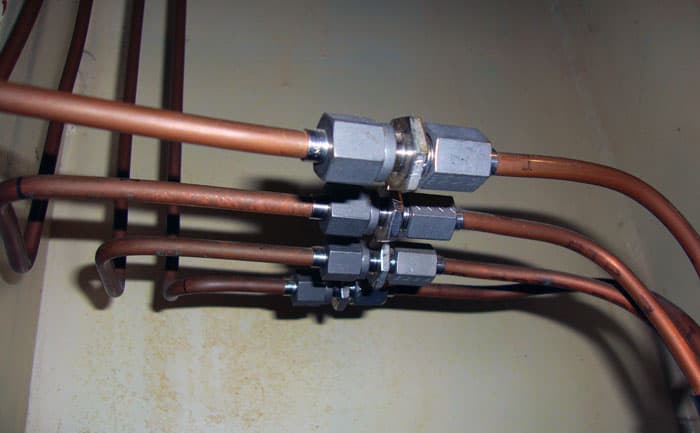Buying a home can be overwhelming as it’s an intense, multi-step process to undertake. Once you find the home and have a contract accepted, an inspector is called out to assess the home’s condition (depending on contract and financing terms).
The inspector will look at various parts of the home and determine their condition and the potential need for replacement prior to finalizing the contract and going to closing.
Once they give their final recommendation, negotiations and additional work may be needed. Then, it’s time to close and the new owners are handed the keys to start their journey in their new (to them) home.
When it comes to the plumbing system for the home, all might look well and fine. But as many as 10 million homeowners in the United States have found, looks can be deceiving.
This guide will provide information on:
- What polybutylene pipes are and why it matters
- Polybutylene pipe lawsuits
- Buying a house with polybutylene pipes
- How to identify polybutylene pipes
- Polybutylene pipe replacement
- Summing it all up
Notice – The contents on this page are not legal advice. I am not a lawyer. I am not your lawyer.
What are Polybutylene Pipes?
Polybutylene, or PB-1, is a type of plastic resin that was used extensively in the late 1970s to mid 1990s to make water supply pipes. You may also hear or read polybutylene called “PB” or by the brand name “Quest” or “Qest.”
It was highly marketed as a low cost, easy to use option for plumbing systems in new home construction from 1978 to 1995. Polybutylene pipes were mainly used in the following regions:
- Mid Atlantic
- South “Sun Belt”
- Pacific Northwest

Polybutylene pipes are flexible and able to maneuver in and around new build construction, so they were easy to integrate for plumbers. They are also resistant to freezing, which is why it was popular in the Mid Atlantic region as well as the warmer areas.
Additional information:
Why Does it Matter?
One of the reasons that polybutylene pipes were so popular and in high demand was because of its longevity. It was a cheaper alternative to copper, which was popular in the 1970s and 1980s. Properly installed, it was meant to last as long as copper.
When polybutylene pipes were first being installed, they were done with a crimping tool to secure pipes and fittings. A few years later, copper fittings were being used to attach polybutylene pipes in the plumbing system. This is mainly due to not crimping properly and causing leaks, either from being too loose or too tight.
There are several factors that can cause leaks or bursts in polybutylene pipes:
- Age of the pipes
- Improperly installed
- Chlorine degradation from municipal water treatment (the most common cause)
Municipal water treatment is considered the main cause and the pipes typically fail closest to the water main where it’s closest to the water source. The interior of the pipe shrinks, causing stress on the exterior and creating small leaks that get weaker over time.

This became so common, a class-action lawsuit was filed in the 1990s, ultimately halting the use of polybutylene pipes.
- Myths about Polybutylene
- Replacing Polybutylene Pipes
- Failure Mechanisms and Lifetime Prediction Methodology for Polybutylene Pipe in Water Distribution System
- Crack Initiation in Engineering Thermoplastics Resulting from Chemical Degradation
Polybutylene Pipe Lawsuits
In 1995, a class-action lawsuit was filed in Tennessee over faulty polybutylene plastic piping.
Cox vs. Shell Oil Co.
The lawsuit, Cox vs. Shell Oil Co., was won and settled for $950 million, allowing affected homeowners the chance to get their pipes replaced for free.

Many people would notice a leak and have it repaired, only to find another leak shortly thereafter. So many people complained, that there were enough claims for the class-action to be filed.
Spencer vs. Shell Oil Co.
There was also another lawsuit filed around the same time, Spencer vs. Shell Oil Co., where $120 million was provided for affected homeowners. In this lawsuit, any homeowner with Poly-B pipe and acetal fittings were eligible even if there was no leak. The lawsuit was settled with DuPont, who made the fittings and not the pipes.

Unfortunately, both settlements have long since expired and affected homeowners are no longer eligible to claim damages or loss. Websites for both settlement funds have been deactivated.
Most homeowners started to notice problems within 10-15 years of their polybutylene pipes being installed. However, some would take even longer, spurring a new class-action lawsuit to be filed in November 2017.
Hurt vs. Shell Oil Co.
Hurt vs. Shell Oil Co. was filed in Arkansas, specifically excluding parties from the first lawsuit. Unfortunately for the new lawsuit homeowners, the case was thrown out with prejudice, so it cannot be refiled.
- Class Action Revisits Settled Case Over Allegedly Defective Shell Oil Polybutylene Piping Systems
- Polybutylene Plumbing Pipes Litigation
Buying a House with Polybutylene Pipes
When purchasing a home that was built between 1978 and 1995, pay special attention to the plumbing system. Disclosures from the previous homeowner or realtor are not required when it comes to polybutylene pipes.
If a house is fitted with PB pipes, an inspector can do a thorough inspection and visually, the pipes could pass. Pressure tests are not recommended and inspectors are not even required to note or mention the material used in the plumbing system in some states.

What’s worse, there could be microscopic leaks or tears inside the flexible polybutylene pipes, which could burst or leak at any time. And leaking pipes can go unchecked for a while if they are hidden behind sheetrock and/or furniture.
A sudden burst might be found quickly, but can still do extensive damage to a home, causing tens of thousands of dollars in repairs.
Even if the home was not built during these years, there is still a chance that it contains polybutylene pipes. This type of piping is no longer sold in the United States but is still being used in other countries, mainly Europe and Asia.
Not sure what to look for? The next section discusses ways to identify polybutylene in plumbing systems.
- Polybutylene Piping Systems
- More on PB Piping
- Buying a Home with Poly?
- Poly Issues for Real Estate Professionals
How to Identify Polybutylene Pipes
As stated above, polybutylene pipes are flexible, plastic resin pipes that could have been used on the interior or exterior of the home.
Here are the characteristics of polybutylene pipes:
- Usually has a stamp reading “PB2110”
- The most popular color is gray, but can also be found in silver, blue, white, and black
- One half to one inch in diameter
- Will be used only for water, not waste, vent, or drain piping
Places to look for PB pipes on the interior of the home:
- Protruding from sinks or toilets into the walls
- In the ceilings of unfinished basements
- By the water heater
- In the washing machine utility box
Places to look for polybutylene pipes on the exterior of the home:
- At the water meter
- Main water shut-off valve (in the basement or lowest level of the home)
Polybutylene is sometimes confused with PEX tubing. PEX is usually used in radiant heating systems and is either white, blue, or red. The colors are noticeably brighter than PB and the tubes are much more flexible and able to coil.
- Types of Plumbing Pipes and their Lifespan
- Polybutylene and Inspectors
- Are Your Polybutylene Water Lines In Danger of Failing?
- The Difference Between PEX and PB
- More on PB Piping
The Cost to Replace Polybutylene Pipes
If the home you are living in or looking to purchase has polybutylene pipes, it’s recommended that the entire plumbing system be replaced immediately. As stated above, a leak can happen at any time and without warning.
Costs to replace a polybutylene plumbing system varies.
Things to consider:
- How much needs to be replaced
- Is it interior and exterior or just interior
- What type of material will be replacing the polybutylene
The average cost to replace polybutylene with PEX or PVC plastic can cost up to $10,000. If copper piping is used, then the cost could be higher, as much as $15,000 or more.

Contractors will also have to cut holes in the walls of the home to access the piping and switch it out. Call around for a few quotes as the same contractor should be able to do the entire job.
If damage has been caused by leaking pipes, stop all work and make sure all materials are saved and not discarded. Call your homeowner’s insurance company to file a claim for any damage. They likely won’t cover the cost of the plumbing system replacement, but insurance policy coverage varies.
Summary
Polybutylene pipes were used extensively in new home construction during the 1970s until the 1990s. Though not banned, polybutylene pipes are no longer sold in the United States market.
Most homes built after 1995 should not have polybutylene pipes, but there may still have been piping available and some plumbers may have still been using them.
Municipal water treatment was found to be the number one cause of polybutylene pipe failure, and homeowners involved in one of two class-action lawsuits were awarded money to replace their plumbing for free. Another lawsuit was filed in 2017 for newly affected homeowners, but the case was closed without a settlement.
If you are looking to purchase a home, look out for the signs of polybutylene piping as inspectors and realtors may not be required to disclose. If you think your home may have polybutylene pipes, have a plumber and/or contractor come out to inspect your home.
While the cost may be expensive to some for pipe replacement, it can be much more costly if damages are incurred. Even if the homeowner’s insurance covers the lose, you may still be on the hook for:
- Deductibles
- Plumbing system replacement
- Higher future premiums
Additional Resources:
Be sure to check out our other resource guides:
